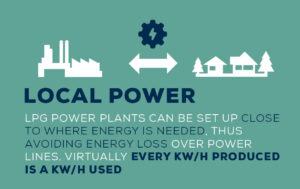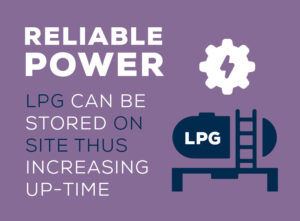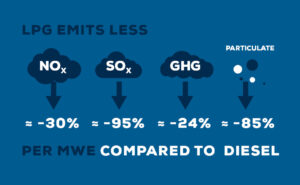The Global Opportunity of LPG for Power By James Rockall, CEO & Managing Director, WLPGA

Since the 1870s, the generation and distribution of electricity has powered global economic development, vastly improved health and enhanced our quality of life in much of the world. Yet today more than 10% of the planet still has no access to electricity, with 75% of these living in sub-Saharan Africa. Of those that are fortunate to have access to electricity, the large majority are dependent on grid-based systems which are vulnerable and over 40% fuelled by coal and oil, contributing significantly to poor air quality and climate change. Studies have shown that decentralised solutions and mini-grids are key in helping deliver affordable and reliable electricity access to the hundreds of millions who are still deprived. This is especially the case in remote rural areas, islands and other geographically challenging parts of the world. The world is moving away from heavy-carbon solid and liquid-fuelled solutions, and as we develop the necessary clean power systems of the future, LPG and renewable LPG (rLPG) have a huge opportunity to contribute to our clean future.
LPG is a unique, exceptional energy. Transported and stored as a liquid, but consumed as a gas, LPG can deliver cleaner, lower emission power than many alternatives currently available. As an example, compared to diesel which is commonly used in decentralised systems; LPG demonstrates a 30% reduction in NOx, 85% lower particulate emissions and a 95% reduction in SOx. In addition, compared to diesel, LPG can reduce greenhouse gas emissions by nearly 25%. These benefits were recognised across the world in a multitude of installations ranging from a large scale 400 MWe plant in Ghana to many medium and small-scale installations. For example, in Chile, a local company providing power to offshore salmon farms has launched a programme to switch electricity generation from diesel to LPG, saving them money and reducing their overall emissions. With the development of renewable LPG, carbon emissions can be lowered by a further 80% compared to traditional LPG, while utilising exactly the same infrastructure and generators, thus ensuring that these systems are effectively future-proof.
Every single country in the world already consumes LPG in a wide range of applications. This enables LPG (and rLPG) to offer accessible and reliable power generation anywhere on the planet today by virtue of the infrastructure in place. LPG is often described as natural gas in a bottle. It provides many of the positive benefits of natural gas while having zero methane leakage and far lower infrastructure costs. LPG is easier and less expensive to compress, ship, and store than LNG, and LPG power plants can be set up close to where energy is needed, avoiding energy loss over power lines, thus improving overall energy efficiency.
As many countries in the world pursue deep decarbonisation targets, there is growing move towards renewable power, mostly with systems derived from wind or solar. While these systems are undoubtedly low carbon, they do not always exhibit suitable availability simply because the wind doesn’t always blow and the sun doesn’t always shine. Backup systems are often needed, especially when high availability is required. The choice of backup is important and critical to the overall functioning system. Selecting the type of back-up is often a cost-benefit analysis between, for instance batteries or generation units based on traditional fuels. In these situations LPG is the ideal partner for renewable power. Its low emissions are compatible with the objectives of a renewable system, while its low infrastructure and operating costs make it an excellent economic choice. This was the conclusion of Innovación Energia S.A. in Chile in the construction of their 45MW back-up power plant in Teno, central Chile. Compared to heavy fuel oil (HFO), LNG or piped natural gas, LPG was shown to be price competitive, allowed fast start up and was able to run without interruptions.
Our world is becoming both increasingly electrified and increasingly low carbon. These two trends provide great opportunity for the growth of LPG-fuelled power systems. As we look to the future, LPG should be the fuel of choice for power generation in many situations. Why? Because with its low emissions and low cost, LPG is the ideal fuel for small-scale distributed generation, serving those areas of the world currently without electricity or those that use highly polluting traditional fuels such as HFO or diesel. As renewable power generation grows, so will the need for back-up generation and here LPG is the ideal partner for renewables worldwide. LPG is already a low carbon, low emissions fuel, but with the advent of renewable LPG, using exactly the same infrastructure, future low-carbon, high-availability electricity generation can be assured.
James Rockall, CEO & Managing Director, WLPGA
About LPG For Power Generation
LPG is the ideal fuel for a wide range of power generation applications, from small backup generators to large scale power plants. All information related to LPG For Power Generation can be found on this page: Power Generation - WLPGA


